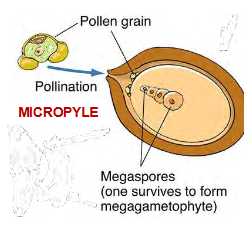FRST 210 lecture 12- sexual reproduction II
1/22
There's no tags or description
Looks like no tags are added yet.
Name | Mastery | Learn | Test | Matching | Spaced |
|---|
No study sessions yet.
23 Terms
Homospory
One type of spore
Each spore germinates into a bisexual gametophyte
Necessitates outcrossing thereby increasing the genetic diversity in offspring
What two types spores do heterosporous plants evolve to
Megaspore → megagametophyte (egg producing)
Microspore → microgametophyte (sperm producing)
Are all gymnosperms heterosporous?
Yes, they are
They bear megasporangia → megasppores) and microsporangia (→ microspores)
have megagametophytes (egg producing) and microgametophytes (sperm producing)
Sexual reproduction in conifers (Pinophyta)
Conifers create seed cones (sporophylls that develop megasporangia
Conifers also develop pollen cones (sporophylls that develop microsporangia)
What do microsporophylls produce
Microsporangia
What do megasporophylls produce
Megasporangia
What are inside each microsporangium (pollen sac)?
Microspore mother cells
How many microspores does one microspore mother cell produce?
Four microspores via mitosis
Each microspore develops into a microgametophyte (pollen grain)
When do cones develop sporangia?
Around february-march
Why are seed cones more complex than pollen cones?
Scales develop two ovules and a sterile bract
An ovule contains the megasporangium that will create megaspores
Ovules are surrounded by a protective integument
Ovuliferous scales
Scales that bear ovules (which contain the megagametophyte) as part of a seed scale complex
Each of these specific cone scales develops a pair of ovules, and each ovule can become a seed if fertilized
Integument
A surrounding protective cover that also bears the megasporangium
How many megaspores do four megaspores via meiosis
It produces four megaspores via meiosis, and only one megaspore survives and develops into a megagametophyte
When is mature pollen released and when does fertilization occur>
~3 weeks after pollination around April-May
Megametophyte inside the ovule develops archegonia with eggs
Airborne pollen are caught by a seed cone and grow a pollen tube to release sperm for fertilization
Advantages of wind pollination
Energy efficient (Requires less energy than attracting pollinators with nectar, scent, and bright colors.
Reliable: Wind is a more consistent pollinator than insects hose populations fluctuate
Seed production: Wind-pollinated plants can produce large quantities of seeds
Independence form pollinators: Wind-pollinated
Disadvantage of wind pollination
May not be as accurate than insect/animal pollination (Most of the pollen produced by wind-pollinated plants doesn’t reach a compatible ovule.)
The pollen produced by wind-pollinated plants is low in nutrition and spoils easily
Hot and humid conditions, as well as rainfall, can limit the success of wind pollination
How does pollen grain fertilize an egg?
Pollen grains arrive at the micropyle (opening of the ovule) while the functional megaspore is still developing into a megagametophyte with eggs

How many archegonia does an ovule have?
It has one megagametophyte with 4-7 archegonia, each conitaning one identical egg cell
Several eggs can be fertilized (polyembryony), but one develops into a mature embryo
When will cone scales disperse seeds?
They will flex open when dry and disperse seeds for several months in fall (September-October)
When do seeds develop and enlarge
July-August
Integument becomes the seed coat (and seed wing)
Megagametophyte persists and nourishes the embryo
In gymnosperms, ovules will still develop into seeds even if they are not fertilized
When are mature seeds are released?
In autumn
during September-October
Embryos enlarge and fill the seed cavity
Megagametophyte has a firm, waxy texture
Seed cones will begin to dry out and look “woody”
Are all gymnosperm species wind pollinated?
Most are, however a few are insect polinated
Some species produce a sticky ‘pollination’ drop to trap pollen near the micropyle of the ovule
Do all conifers undergo sexual reproduction with cones? How long does it take for a full reproductive cycle?
Yes, most take one full reproductive cycle (except pines that take two years)
Cone “crops” are periodic, with large crops every 2-7 years